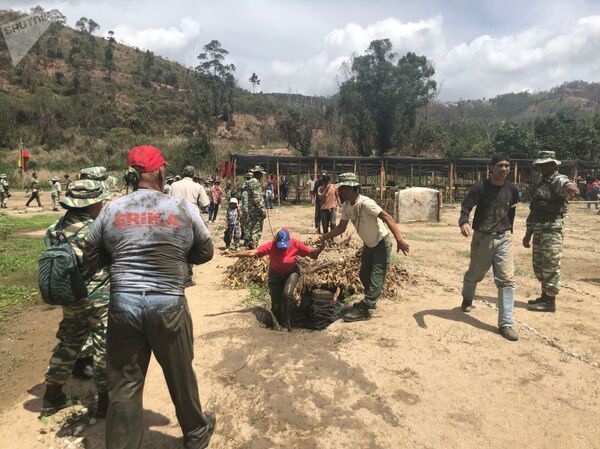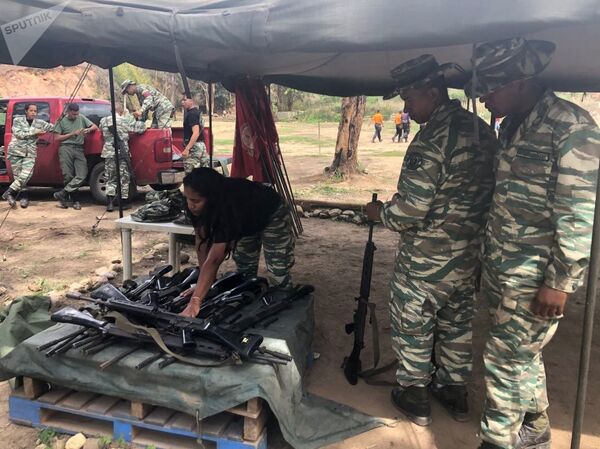She and many thousands of others are preparing to defend Venezuela against a possible military invasion of the country.

They call it the ‘Tactical Method of Revolutionary Resistance’ and it includes training civilians on basic military techniques “to defend the homeland” without necessarily creating military units.
Every Saturday, in groups of 200, they meet at a sports field at an agricultural school in the neighborhood of Caricuao adapted for Bolivarian crossfit classes. They must go through 13 “challenges” and learn techniques and then practice and improve.

First, they get to a makeshift “operations centre” – a military tent – where they learn theory, namely what is war and how they should act in case of a combat operation. They learn some basics for “dummies” on how to move, how to act, how to protect themselves, as well as who to trust if there is a war in Venezuela.
They learn first aid and communication techniques, and they learn to identify poisonous plants. They also learn self-defence techniques, how to identify an enemy, how to build a trap, and how to camouflage themselves, use an automatic rifle and bear the effects of tear gas.

Astrid comes from the Parish of La Candelaria, located in the center of Caracas and known for Spanish taverns and fierce clashes on the “guarimbas” – the barricades erected by the opposition during the street riots of 2014 and 2017.
“We learned to defend our country there, and now we know what to do in case we go back to another similar episode,” Astrid says.

At her age, she is not as mobile and flexible as other young volunteers, but manages easily to overcome an obstacle course. Then Astrid jumps on a row of tires that are about 50 centimeters in diameter, explaining that “of course, there are things that a woman my age cannot do as easily as a man or, in general, some younger people”.
Ante la posibilidad de una invasión extranjera o disturbios internos, los civiles venezolanos aprenden a través del #MétodoTácticoDeResistenciaRevolucionaria desde primeros auxilios hasta técnicas de defensa personal. pic.twitter.com/gP2iKtd7bk
— Sputnik Reporteros (@Sputnik_Report) 18 June 2019
“But it doesn’t matter, since anyone can help; not everything requires great physical effort, we can train young volunteers or provide information to the security forces”, Astrid explains.
The woman notes that volunteers learn protocols of action in case of attack, whether by a foreign agent – in case of a US invasion – or by the opposition party.

“Everywhere there are true patriots of Venezuela, and if something happens, they would give an early warning of possible provocations. Based on these reports, we would have to find out how many people oppose us, what kind of weapons they have… We take photos and videos and we pass them on to the state security service, which we always work closely together with,” Astrid says.
Leales a la #RevoluciónBolivariana, muchos civiles participan de los entrenamientos militares del #MétodoTácticoDeResistenciaRevolucionaria en defensa del Gobierno de #Venezuela. pic.twitter.com/ozTQnFmzxj
— Sputnik Reporteros (@Sputnik_Report) 18 June 2019
"La Candelaria has many tall buildings and their flat roofs are our advantage in the war with enemies of the people. From there we can see everything”, the woman says.
Venezuelan Army Major Jesús Orozco is responsible for training volunteers in Caricuao. Usually jocular, he becomes strict when addressing civilian apprentices, using the classic military tone when talking to them.

“Venezuela will never kneel before the invaders. I am convinced that our country has always been and will be free, because we are the heirs of the glory of the great Bolivar”, he says.
The major knows that these people could be used as a weapon of mass destruction. While the world underestimates them because of their appearance or age, the Chavists realise the importance of having people on their side, faithful to the Bolivarian covenants that give the strength to protect their national identity and socialism.
“People don’t realise that a 50-year-old lady is more dangerous than the most advanced plane or war tank. A war tank or aircraft emits heat and therefore any defence system can detect and destroy it, while a person, being in a house with a firing device, can easily set off an explosion in the right place".

This is key to understanding why Venezuela and the government of Nicolás Maduro won’t fall. There are common people, powerful people that support the Chavists and their ideals; people who have been loyal to these ideals for 2 decades of the Revolution, no matter what.
Major Orozco is aware of who those people are who have volunteered to be trained in Caricuao: “They [foreign countries, the US, the opposition] may tread Venezuela but they will not leave from here walking”.

“We are ready to lay down our lives for our country; and if our enemies that want to invade Venezuela think they’ll find obedient people here, they heavily underestimate Venezuelans,” the major assures.
This statement is impressive since it comes from a representative of a people experiencing the most severe economic crisis and international isolation. “We are always loyal. But we will never be traitors”, all the volunteers say.
En los entrenamientos del #MétodoTácticoDeResistenciaRevolucionaria, los civiles mantienen en ánimo con gritos y cánticos a favor de la #RevoluciónBolivariana pic.twitter.com/1lP6lF3Dl1
— Sputnik Reporteros (@Sputnik_Report) 18 June 2019
Volunteers are divided into groups and proceed to one of the 13 “challenges” or classes where they have to learn to do various exercises until all participants complete a full circle of training.

In addition to Major Orozco and other officers, there are several dozens of militias from the Military-Civil Association (an organization recognised by the Constitution of the Bolivarian Republic of Venezuela), who also engage in the training of volunteers.
One is a short, thin man around 60 years old, dressed in a green camouflage uniform, who holds an automatic rifle and shows volunteers how to assemble and disassemble, charge and aim it, although the weapon seizes several times during the class.

This man is like a walking military encyclopedia: “This rifle was used in all wars…” he says about the weapon that has been used since the second half of the 20th century.
“This Belgian rifle was used as a combat weapon for infantry. There are some words in French here”, he explains. Some group members take notes in their notebooks. One of them translates the lecture into sign language and copies the instructor’s poses, showing how to properly hold a rifle – one shoulder forward, fingers away from the trigger, legs slightly apart.

Another group of volunteers is going through the “movement technique” challenge to move properly. Then, in a strategic combat pose, they do squatting with a gun in small groups of two or three. 69-year-old Dulce Núñez comes to the training for the sixth time. She easily moves around the training ground, as if she knows it like the back of her hand.
"La gente no sabe que es más peligrosa una señora de 50 años que el avión o el tanque de guerra más poderoso del mundo", asegura el oficial Jesús Orozco, sobre el #MétodoTácticoDeResistenciaRevolucionaria que entrena civiles para actuar en caso de una invasión a Venezuela pic.twitter.com/9hlo4oJNSa
— Sputnik Reporteros (@Sputnik_Report) 18 June 2019
Astrid believes that she should be here to train volunteers; she speaks of the training as if it were part of her life. It’s surprising how freely she talks about ways to protect against tear gas attacks.

“The gas is sprayed in the air, and you just have to endure. You have to survive the inconvenience of this “strange element” in the air.” “And how long does this usually stay in the air?” – “It fades away very quickly.” – “Do you bear this easily, do you have watery eyes?” – “I do have very watery eyes, but I can bear it. This has already become a habit.”
The last challenge is just before lunch, this is an obstacle course; then a feast is held with games, dances and sports. Everyone has fun and looks happy. Some declare political slogans: “For the Motherland!”, “For Bolivar!”, “For Chavez!”

An elderly woman, 75 years of age, moves without assistance, holding on a stretched rope. She is wearing a red blouse, her face is painted with black paint, and the surrounding people are cheering her on. They train their bodies and their spirit. Their ability to resist and self-organization is striking.






